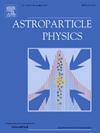Non-parametric analysis for the dark matter density evolution
IF 2.9
3区 物理与天体物理
Q1 ASTRONOMY & ASTROPHYSICS
引用次数: 0
Abstract
In this paper, we investigate a potential departure in the standard dark matter density evolution law, . The method involves considering a deformed evolution model, denoted as , and searching for the presence of any deviation (). As one may see, is a general function that parametrizes a possible digression from the standard law. We use data of baryon acoustic oscillations, type I Supernovae luminosity distances, and galaxy cluster gas mass fraction observations to reconstruct through an approach that is not dependent on the cosmological model or the so-called Gaussian process regression. Unlike previous works, it enables us to investigate a possible deviation without using a specific function to describe it. We have obtained , the standard model scenario, within c.l. in all the considered cases.
暗物质密度演化的非参数分析
本文研究了标准暗物质密度演化规律ρdm=ρdm,0(1+z)3的潜在偏离。研究方法包括考虑一个变形演化模型,表示为ρdm=ρdm,0(1+z)3f(z),并寻找是否存在任何偏离(f(z)≠1)。可以看出,f(z)是一个通用函数,它是标准定律可能偏离的参数。我们利用重子声振荡数据、I型超新星光度距离和星系团气体质量分数观测数据,通过一种不依赖于宇宙学模型或所谓高斯过程回归的方法来重建f(z)。与以往的研究不同,它使我们能够在不使用特定函数描述的情况下研究可能的偏差。在所有考虑的情况下,我们都在 2σ c.l. 以内得到了 f(z)=1,即标准模型情况。
本文章由计算机程序翻译,如有差异,请以英文原文为准。
求助全文
约1分钟内获得全文
求助全文
来源期刊

Astroparticle Physics
地学天文-天文与天体物理
CiteScore
8.00
自引率
2.90%
发文量
41
审稿时长
79 days
期刊介绍:
Astroparticle Physics publishes experimental and theoretical research papers in the interacting fields of Cosmic Ray Physics, Astronomy and Astrophysics, Cosmology and Particle Physics focusing on new developments in the following areas: High-energy cosmic-ray physics and astrophysics; Particle cosmology; Particle astrophysics; Related astrophysics: supernova, AGN, cosmic abundances, dark matter etc.; Gravitational waves; High-energy, VHE and UHE gamma-ray astronomy; High- and low-energy neutrino astronomy; Instrumentation and detector developments related to the above-mentioned fields.
 求助内容:
求助内容: 应助结果提醒方式:
应助结果提醒方式:


